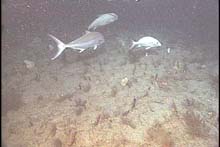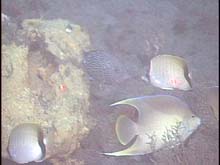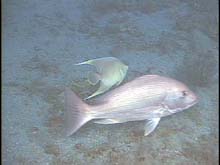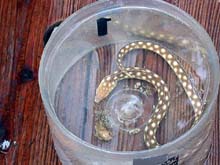
These amberjack and snapper were seen at the bottom of the ocean at Savannah Scarp on Sept. 8. Click image for larger view.

This photo shows a juvenile speckled hind (top middle), two reef butterflyfish, and a blue angelfish. The submersible uses the two laser lights (left) to measure the size of the organisms observed. The distance between the two lasers is 25 cm. Click image for larger view.

A blue angelfish and a red snapper swim along the ocean floor. Click image for larger view.

This sharptail eel is an example of the diversity found on Sandwich Reef at the Savannah Scarp. Click image for larger view.
Red Snappers at Sandwich Reef
September 8, 2001
George Sedberry
Chief Scientist
Savannah Scarp Mission
Following are observations from the research submersible Clelia at Sandwich Reef on the Savannah Scarp.
Descending 200 ft from the warm, sunlit blue surface waters to the cooler, greener rocky bottom revealed an unexpected but pleasant surprise -- red snapper, and lots of them. Among the first fishes seen as the sub approached the rocky rubble of Sandwich Reef were schools of small red snapper. Most were below the minimum legal catch size of 20 in, but their presence indicated that this reef is an important habitat for young red snapper, a highly desired food fish.
This portion of the Savannah Scarp does not have the spectacular 25- to 35-ft-high rock outcrops often found at the reefs that form the continental shelf edge off the southeastern U.S coast. Those reefs tend to harbor large schools of vermilion snapper and red porgy. Instead, the bottom at Sandwich Reef consists of low ridges with rocky outcrops, scattered small and medium rocks, and rocky rubble. Often, the hard bottom appears like a potholed pavement, with the potholes occupied by bright-red bigeyes (glasseye snapper), squirrelfish, soapfish, and moray eels. Hovering above the hard bottom and rock outcrops are medium to large groupers, including scamp and gag, and a few speckled hinds. Greater amberjack and almaco jacks circled the submersible.Our observations at Sandwich Reef indicate that red snapper, gag and scamp are often found associated with low rock outcrops, the dominant bottom type found here. Porgies, such as red porgy and knobbed porgy, were relatively rare over these low, hard bottoms. These low reefs are also popular with small, colorful reef fish, such as butterflyfish (including bank, reef, and spotfin butterflyfish), yellowtail reeffish, and bicolor damselfish.
The bottom at Sandwich Reef consists of hard limestone outcrops and extensive sand flats. Large ripple marks in the sand indicate that steady currents flow over the bottom. Relatively low visibility at this site (30 ft of horizontal visibility) indicates a lot of plankton production in the water column. The Sandwich is a highly productive area for reef fishes.Whereas shallower shelf reefs, such as Gray's Reef, are dominated by black sea bass, the Sandwich is dominated by red snapper, gag, scamp, greater amberjack, and gray triggerfish. Although geographically close to Gray's Reef, Sandwich Reef is deeper, and is closer to the warm and thermally stable waters of the Gulf Stream. For this reason, its fish fauna is more tropical.
Sign up for the Ocean Explorer E-mail Update List.











































